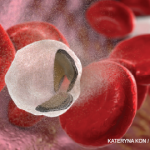
Lupus patients are at increased risk for heart-related complications.
Kateryna Kon / SHUTTERSTOCK.COM
SAN DIEGO—To manage patients with systemic lupus erythematous (SLE), rheumatologists must be aware of potentially serious complications affecting many organ systems. On Nov. 7 at the 2017 ACR/ARHP Annual Meeting, two experts offered insights on cardiovascular and hematological complications of lupus.
Myocardial Disease in Lupus
Lupus patients are at increased risk for heart-related complications, especially during times of high disease activity, said Susan Manzi, MD, MPH, director of the Lupus Center for Excellence at Allegheny Health Network in Pittsburgh.
Endomyocardial biopsy is the gold standard for diagnosing myocarditis in these patients, and it can show signs of fibrosis or inflammation. “Myocarditis tends to be patchy, so endomyocardial biopsies can be tricky. That’s why the recommendation is to do multiple biopsies,” said Dr. Manzi. “The problem is that endomyocardial biopsies are invasive, if relatively safe.” Cardiac magnetic resonance imaging (MRI) is a diagnostic alternative to identify problems in the myocardium.

Dr. Manzi
“Myocardial disease can be caused by ischemia, including ischemia of the epicardial vasculature or the coronary arteries, but also ischemia of the coronary microvasculature,” said Dr. Manzi. Microvascular dysfunction, previously called Syndrome X, is seen more in women and people with autoimmune diseases. Symptoms include chest pain and ischemic changes to normal coronary arteries. Infections and drugs are other possible causes of myocardial dysfunction.
Heart failure is also more common in lupus, said Dr. Manzi. In a new, large study of 48 million American adults, including 95,000 with SLE, “you see a dramatic increase of heart failure in lupus compared to the general population.1 You don’t see heart failure in the general population until people are in their 50s or 60s, but in lupus, the relative risk is dramatically increased,” even among people in their 20s. Patients with lupus nephritis have a tenfold increased relative risk for heart failure, she said.
“What were the independent predictors of heart failure in lupus patients? Even after you control for general risk factors, lupus remains an independent risk factor. Also, coronary artery disease, hypertension and valvular disease all influence rates of heart failure, and all of those are increased in lupus.”
Lupus patients are at increased risk of epicardial vascular disease and atherosclerotic cardiovascular disease, even in their 20s.2 Younger women with SLE have about a two- to tenfold increased risk of myocardial infarction, including before or shortly after their lupus diagnosis, she said.3 Cardiac MRI can help confirm a previous MI in these patients.
Chronic inflammation can lead to microvascular dysfunction even in lupus patients who have no typical cardiovascular risk factors or symptoms. These patients may have a reduced coronary flow reserve in response to stress testing, as a 2009 study showed, said Dr. Manzi.4 In the study seven of 25 women with lupus or rheumatoid arthritis showed ischemic changes on their electrocardiograms, even in the setting of minimal or no epicardial coronary artery disease. “These changes were associated with increased disease activity. When you treat the patient’s disease, or when disease is inactive, you may see a reversal.”
Multiple Mechanisms
Several mechanisms may play a role in coronary microvascular dysfunction in SLE patients, said Dr. Manzi.
“There appears to be impaired microvascular dilation, which should happen during stress testing, where there should be increased hyperemia,” she said. Patients may also have increased microvascular constriction. Treatments with calcium-channel blockers or angiotensin-converting enzyme (ACE) inhibitors have shown mixed results. Rheumatologists should evaluate patients who may have angina-like chest pain, but normal coronary arteries, and consider various agents to treat their microvascular disease or simply reduce pain perception, she said.
Infections may set off an inflammatory reaction like acute myocarditis in lupus patients, who may present with symptoms like chest pain, heart failure or tachyarrhythmias. These problems may resolve, persist or progress and result in myocardial scarring. Myocarditis induced by viral infections like chlamydia, coxsackie, parvovirus, herpes or cytomegalovirus is more common in the U.S., but bacterial and fungal infections are possible culprits, too.5
“Always do an endomyocardial biopsy in the setting of unexplained, new-onset heart failure of less than two weeks or up to three months, particularly if the patient has arrhythmias,” she said. Cardiac MRI is useful to diagnose non-infectious lupus myocarditis. Imaging often shows abnormalities in the myocardium, pericardium and endocardium, suggesting pancarditis in these patients.
“Fortunately, with treatment, you can often see improvement. That’s why I like cardiac MRIs, because you can use them to follow response to therapy,” said Dr. Manzi. Treatments include ACE inhibitors or diuretics, and corticosteroids are the mainstay therapy to reduce the inflammation. Other options are mycophenolate mofetil, azathioprine and cyclosporine, and intravenous immunoglobulin (IVIG) if viral causes are suspected, she said. Rheumatologists should be aware that some drugs may cause myocardial toxicity, including cocaine, ethanol and antimalarials.6
Autoimmune Anemia & Thrombocytopenia

Dr. Gernsheimer
About 10% of lupus patients may develop autoimmune hemolytic anemia (AIHA), so overall, it is a relatively rare syndrome, said Terry B. Gernsheimer, MD, professor of medicine at the University of Washington in Seattle.7 Available clinical data on AIHA are not specific to lupus, she said. About 75% of people with AIHA present with anemia at first, and it may be “a waxing and waning disease.”
Patients with AIHA may rarely have severe complications, such as Evans syndrome, an autoimmune anemia associated with immune thrombocytopenia. Thrombocytopenia may occur before, after or along with hemolytic anemia and may be symptomatic with bleeding, she said. About 30% of people with AIHA test positive for antinuclear antibodies (ANA), even if they don’t have SLE, although many patients may develop lupus later. When AIHA warm autoantibodies are in high titer, they may also fix complement. Usually, this occurs in patients with very severe hemolysis.
Laboratory testing of AIHA patients typically shows elevated reticulocyte, increased lactate dehydrogenase (LDH), decreased haptoglobin and increased bilirubin (direct > indirect), said Dr. Gernsheimer. Because this type of hemolysis tends to be extravascular, it is uncommon to see either hemoglobinemia or hemoglobinuria in these patients unless the hemolysis is very severe.
“One of the most important things we do as hematologists is look at the peripheral blood smear. Here, we do the direct anti-globulin or Coombs test. This is particularly true in lupus patients,” said Dr. Gernsheimer. “Don’t assume if a patient has a history of AIHA that was Coombs positive that the next time you see them hemolyzing, it’s the same thing. It is important to rule out other causes of hemolysis that may be seen in patients with lupus.”
Normally, red blood cells have a great deal of redundant membrane that gives the cell a concave, disc shape. Cells are able to change shape easily and move through small vessels delivering oxygen, she said. When antibodies attach to the red cells, they are recognized by macrophages, which engulf the cell or chew off a portion of it. As a result, the cells lose membrane and their concave shape, are smaller and develop a sphere shape, turning into spherocytes.
Temperature Matters
The Coombs test, or direct antiglobulin test for hemolysis, involves taking the patient’s antibody-coated red blood cells and incubating them with Coombs serum, an anti-human immunoglobulin, said Dr. Gernsheimer. “There will be cross-linking, and these cells will agglutinate. The technician, hopefully, if they are experienced enough, will see these cells fall to the bottom of the test tube. The technician can visually see and measure the agglutination—but it’s not nearly as specific as you might think.”
AIHA patients are mostly warm antibody mediated, but not always. In cold antibody mediated AIHA, complement is fixed. Agglutination will be seen with anti-C3 Coombs sera. If cold antibody-mediated AIHA is suspected, it may be important to perform a thermal amplitude, where the technician checks for antibody binding at higher temperatures—most testing is done at room temperature—to see if the antibody is active at physiologic temperature.
Hematologists look for the patient’s underlying disorder or immune dysregulation when selecting treatment, said Dr. Gernsheimer. Even in lupus patients, other causes, such as hepatitis C or chronic lymphocytic leukemia (CLL), may cause the anemia. First-line therapy is corticosteroids at 1 to 1.5 mg/kg a day for one to three weeks to rapidly control the anemia. Patients should also take 1–2 g of folate daily, because of their rapid turnover of red blood cells. Transfusion is generally used only when the patient is very symptomatic, because allo-antibodies may not be easily detected, and a clean cross-match may not be possible.
For diagnosing primary immune thrombocytopenia (ITP), previously known as idiopathic thrombocytopenic purpura, definitive testing similar to the Coombs test is not available.8 This is a diagnosis of exclusion, said Dr. Gernsheimer. Diagnosis may be confirmed when the patient responds to appropriate therapy such as corticosteroids or IVIG. Testing should include quantitative immunoglobulin levels. Hematologists may also test for and treat H. pylori, as the infection could play a role in this condition, as well as test for antiphospholipid antibodies, hypothyroidism and viral infections. Rituximab may be used to treat ITP, but its efficacy tends to decline over time, and if duration of response is less than one year, it is usually not recommended for repeat therapy, she said.
Surgery Risks
Splenectomy has lower response rates in lupus patients with thrombocytopenia than the primary disorder, said Dr. Gernsheimer. “If these patients do fail, and then we have to switch to other immunosuppressant agents, this could be a problem, because you have a patient who is already relatively immunosuppressed due to their splenectomy.”
In ITP, in addition to accelerated platelet destruction, platelet production by megakaryocytes is suppressed, probably by antiplatelet autoantibodies. There may also be direct T cell targeting.9 Therapies include romiplostim or eltrombopag; both drugs bind to the thrombopoietin receptor on the megakaryocyte and increase platelet production. Some patients with chronic ITP may need indefinite therapy with these drugs; their side effects are fairly mild. Many patients can discontinue treatment after remission, she said.
Recent research has shown that ITP patients’ cellular and cytokine profiles are “consistent with an inflammatory state and decreased autoimmune regulatory function. Patients in remission have a shift in this balance,” said Dr. Gernsheimer. “It’s possible that monitoring cytokines and cellular mRNA levels could inform us about whether there may be a response to a therapy or a relapse, and lead us to new therapeutic opportunities.”
Susan Bernstein is a freelance journalist based in Atlanta.
References
- Chang HK, Al-Kindi SG, Jandali B, et al. Incidence and risk of heart failure in systemic lupus erythematosus. Heart. 2017;103(3):227–233.
- Schoenfeld SR, Kasturi S, Costenbader KH. The epidemiology of atherosclerotic cardiovascular disease among patients with SLE: A systematic review. Semin Arthritis Rheum. 2013 Aug;43(1):77–95.
- Urowitz MB, Gladman DD, Anderson MM, et al. Cardiovascular events prior to or early after diagnosis of systemic lupus erythematosus in the systemic lupus international collaborating clinics cohort. Lupus Sci Med. 2016 Apr;3(1):e000143.
- Recio-Mayoral A, Mason JC, Kaski JC, et al. Chronic inflammation and coronary microvascular dysfunction in patients without risk factors for coronary artery disease. Euro Heart Jour. 2009;30:1837–1843.
- Calabrese F, Thiene G. Myocarditis and inflammatory cardiomyopathy: Microbiological and molecular biological aspects. Cardiovasc Res. 2003;60:11–25.
- Tselios K, Gladman DD, Harvey P, et al. Prolonged antimalarial treatment increases the risk for severe brady-arrhythmias in systemic lupus erythematosus [abstract 1590]. Arthritis Rheumatol. 2017;69(suppl 10).
- Gormezano NW, Kern D, Pereira OL, et al. Autoimmune hemolytic anemia in systemic lupus erythematosus at diagnosis: Differences between pediatric and adult patients. Lupus. 2017 Apr;26(4):426-430.
- Provan D, Stasi R, Newland AC, et al. International consensus report on the investigation and management of primary immune thrombocytopenia. Blood. 2010; 115: 168–186.
- McMillan R, Wang L, Tomer A, et al. Suppression of in vitro megakaryocyte production by antiplatelet autoantibodies from adult patients with chronic ITP. Blood. 2004, 103:1364–1369.


